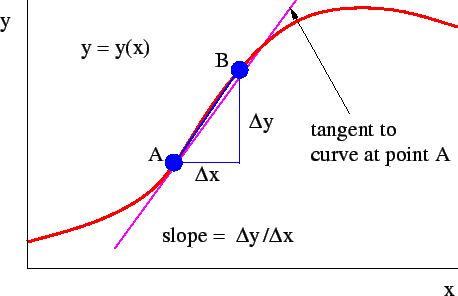Waves/Derivatives
< WavesWaves : 1 Dimensional Waves
1 - 2 - 3 - 4 - 5 - 6 - 7 - 8 - 9 - 10 - 11 - 12 - 13
Examples - Problems - Solutions - Terminology
Math Tutorial -- Derivatives

Figure 1.15: Estimation of the derivative, which is the slope of the tangent line. When point B approaches point A, the slope of the line AB approaches the slope of the tangent to the curve at point A.
This section provides a quick introduction to the idea of the derivative. For a more detailed discussion and exploration of the differentiation and of Calculus, see Calculus and Differentiation.
Often we are interested in the slope of a line tangent to a function  at some value of
at some value of  . This slope is called the derivative and is denoted
. This slope is called the derivative and is denoted  . Since a tangent line to the function can be defined at any point
. Since a tangent line to the function can be defined at any point  , the derivative itself is a function of
, the derivative itself is a function of  :
:
 (2.25)
(2.25)
As figure 1.15 illustrates, the slope of the tangent line at some point on the function may be approximated by the slope of a line connecting two points, A and B, set a finite distance apart on the curve:
 (2.26)
(2.26)
As B is moved closer to A, the approximation becomes better. In the limit when B moves infinitely close to A, it is exact.
Table of Derivatives
Derivatives of some common functions are now given. In each case  is a constant.
is a constant.
| Table of Derivatives | |
|---|---|
 | |
 | |
 | |
 | |
 | where both xc and cxc-1 are defined. |
 | |
 | |
 | x > 0 |
 | c > 0</math> |
 | |
 | c > 0,  |
 | |
 | |
 | |
 | |
 | |
 | |
 | |
 | |
 | |
 | |
 | |
 | |
 | |
 | |
 | |
 | |
 | |
 | |
 | |
 | |
 | |
 | |
 | |
 | |
 | |
The product and chain rules are used to compute the derivatives of complex functions. For instance,
and
Waves : 1 Dimensional Waves
1 - 2 - 3 - 4 - 5 - 6 - 7 - 8 - 9 - 10 - 11 - 12 - 13
Examples - Problems - Solutions - Terminology

